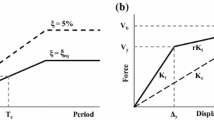Abstract
This paper examines the distribution of seismic drift demands in multi-storey steel moment frames designed to the provisions of Eurocode 8, with due account of the frequency content of ground motion. After providing an overview of current design rules, selected results from a detailed parametric investigation into inelastic drift demands are presented and discussed. The study includes extensive incremental dynamic analyses covering a wide range of structural characteristics and a large suite of ground motion records. The mean period is adopted in this work as a measure of the frequency content of ground motion. Prediction models for maximum global and inter-storey drift demands are presented and shown to be primarily affected by the fundamental-to-mean period ratio and the behaviour factor. Particular attention is given in this paper to the influence of the relative storey stiffness ratio on the distribution of drift demands over the height of the structure. In order to achieve a comparatively uniform drift distribution, a target relative storey stiffness ratio, incorporating the structural and ground motion characteristics, is proposed for design purposes. Finally, the implications of the findings on typical design procedures are highlighted, and possible improvements in codified guidance are discussed.












Similar content being viewed by others
References
ASCE/SEI (2005) Minimum design loads for buildings and other structures, ASCE 7–05. American Society of Civil Engineers/Structural Engineering Institute, Reston, VA
CEN (2004) EN 1998–1, Eurocode 8: design of structures for earthquake resistance—part 1: general rules, seismic actions and rules for buildings. European Committee of standardization, Brussels
CEN (2005) EN 1993–1-2. Eurocode 3: design of steel structures, part 1. 1: general rules and rules for buildings. European Committee of standardization, Brussels
Chopra AK, Chintanapakdee C (2004) Inelastic deformation ratios for design and evaluation of structures: single-degree-of-freedom bilinear systems. J Struct Eng 130(9):1309–1319
Elghazouli AY (ed) (2009) Seismic design of buildings to Eurocode 8. Taylor and Francis, Spon Press
Elghazouli AY (2010) Assessment of European seismic design procedures for steel framed structures. Bull Earthq Eng 8(1):65–89
Fajfar P (2000) A nonlinear analysis method for performance-based seismic design. Earthq Spectra 16:573–593
FEMA (2000) FEMA 356—prestandard and commentary for the seismic rehabilitation of buildings. Federal Emergency Management Agency, Washington
FEMA (2005) FEMA 440—improvement of nonlinear static seismic analysis procedures. Federal Emergency Management Agency, Washington
Hajirasouliha I, Moghaddam H (2009) A new lateral force distribution for seismic design of structures. J Struct Eng 135(8):906–915
ICBO (2006) International building code, international conference of building officials, Whittier, CA
Karavasilis TL, Bazeos N, Beskos DE (2008) Drift and ductility estimates in regular steel MRF subjected to ordinary ground motions: a design-oriented approach. Earthq Spectra 24(2):431–451
Karavasilis T, Seo C, Makris N (2011) Dimensional response analysis of bilinear systems subjected to non-pulselike earthquake ground motions. J Struct Eng (ASCE) 137(5):600–606
Kumar M (2012) Inelastic seismic response assessment of moment resisting steel frames. PhD Thesis, Department of Civil and Environmental Engineering, Imperial College London, UK
Kumar M, Castro M, Stafford PJ, Elghazouli AY (2011) Influence of the mean period of ground motion on the inelastic dynamic response of single and multi degree of freedom systems. Earthq Eng Struct Dyn 40:237–256
Kumar M, Stafford PJ, Elghazouli AY (2013) Influence of ground motion characteristics on drift demands in steel moment frames designed to Eurocode 8. Eng Struct 52:502–517
Medina AR (2004) Storey shear strength patterns for the performance based seismic design of regular frames. ISET J Earthq Technol 44(1):101–125
Medina AR, Krawinkler HJ (2005) Evaluation of drift demands for the seismic performance assessment of frames. Struct Eng 131(7):1003–1013
Miranda E (2000) Inelastic displacement ratios for structures on firm sites. J Struct Eng 126(10):1150–1159
NEHRP (2009) NEHRP (National Earthquake Hazard Reduction Program) recommended provisions for new buildings and other structures (FEMA P-750), 2009 edn. Building Seismic Safety Council, National Institute of Building Sciences, Washington, DC
OpenSees, OpenSees Version 2.0.0. http://opensees.berkeley.edu/index.php, 2008
Park K, Medina A (2007) Conceptual seismic design of regular frames based on the concept of uniform damage. J Struct Eng 133(7):944–955
Pettinga JD, Priestley MJN (2005) Dynamic behaviour of reinforced concrete frames designed with direct displacement-based design. J Earthq Eng 9(2):309–330
Rathje EM, Abrahamson NA, Bray JD (1998) Simplified frequency content estimates of earthquake ground motions. J Geotech Geoenviron Eng 124(2):150–159
Rathje EM, Faraj F, Russel S, Bray JD (2004) Empirical relationships for frequency content parameters of earthquake ground motions. Earthq Spectra 20(1):119–144
Uang CM, Maarouf A (1994) Deflection amplification factor for seismic design provisions. J Struct Eng 120(8):2423–2436
Vidic M, Fajfar P, Fischinger M (1994) Consistent inelastic design spectra: strength and displacement. Earthq Eng Struct Dyn 23(5):507–521
Author information
Authors and Affiliations
Corresponding author
Rights and permissions
About this article
Cite this article
Elghazouli, A.Y., Kumar, M. & Stafford, P.J. Prediction and optimisation of seismic drift demands incorporating ground motion frequency content. Bull Earthquake Eng 12, 255–276 (2014). https://doi.org/10.1007/s10518-013-9568-7
Received:
Accepted:
Published:
Issue Date:
DOI: https://doi.org/10.1007/s10518-013-9568-7




